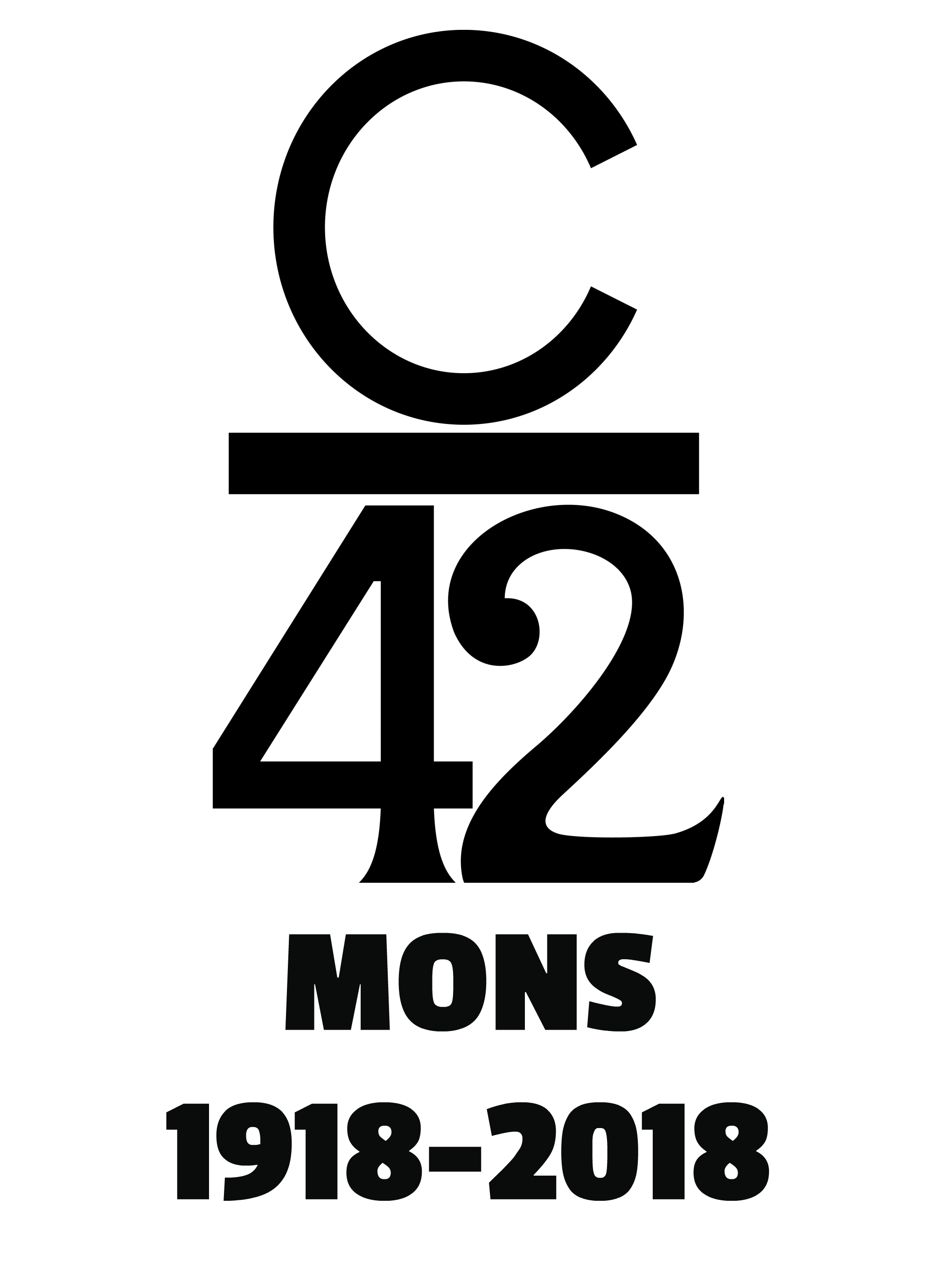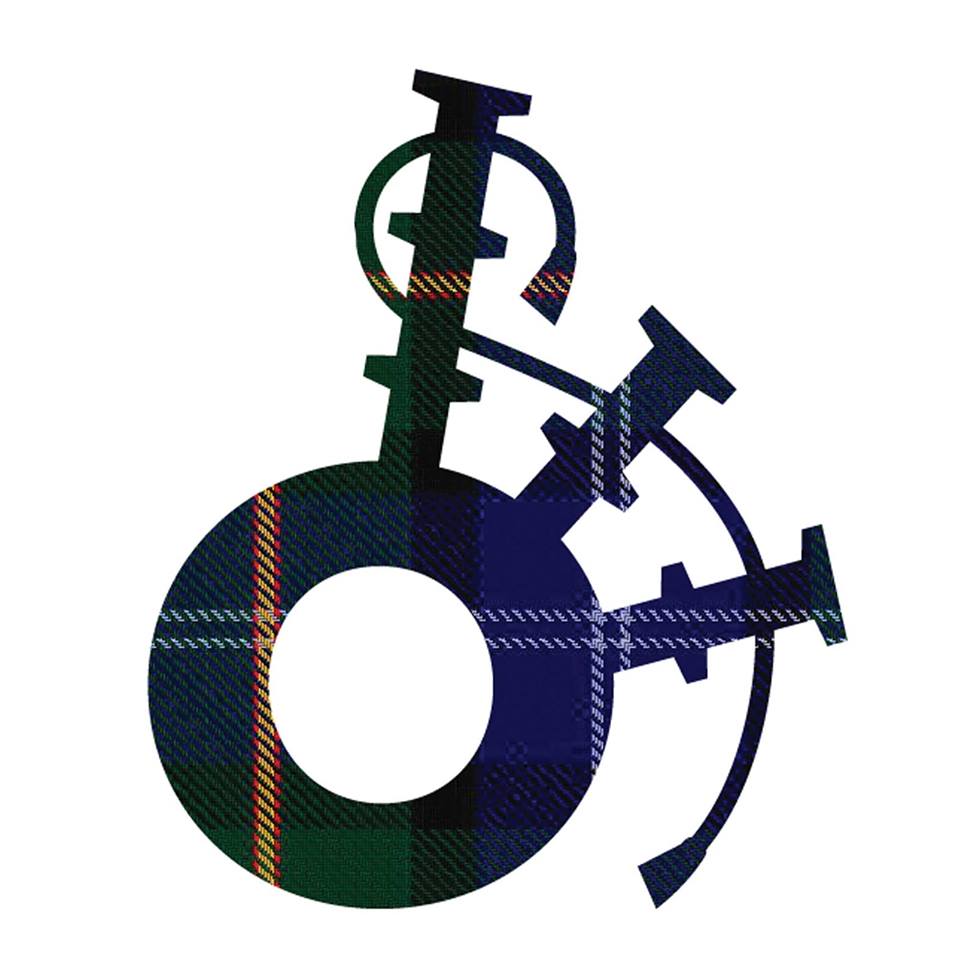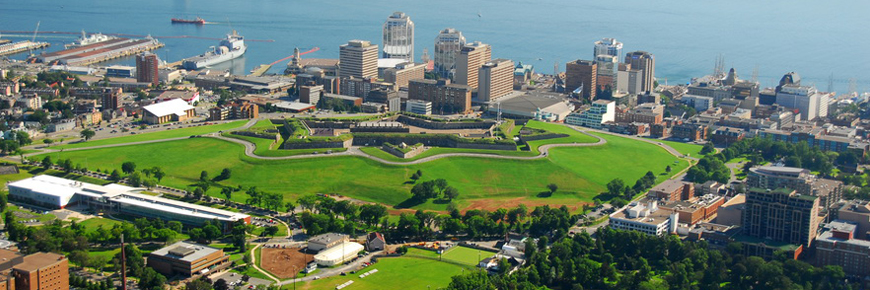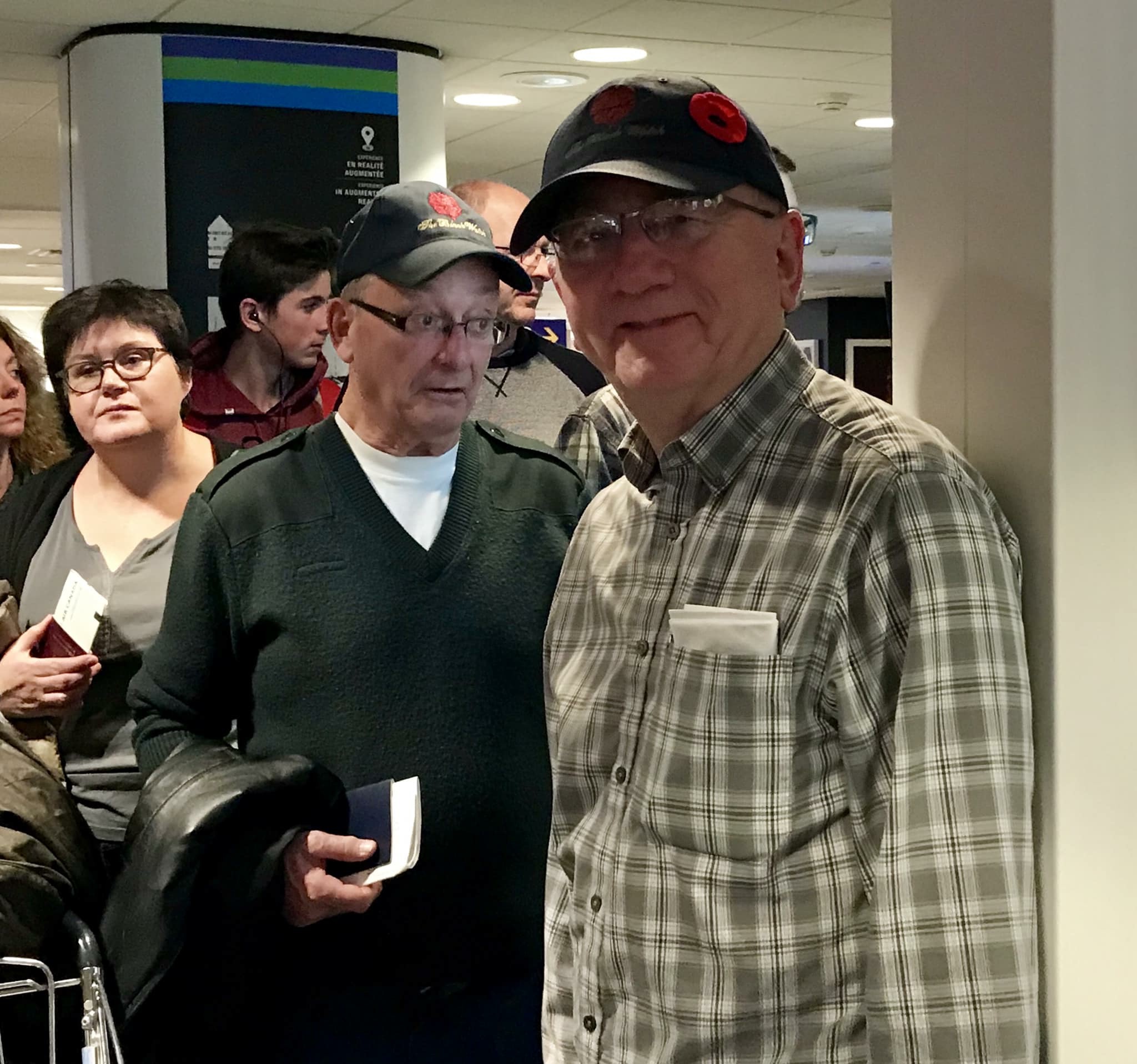
- Details
First wave of contingent departs
The airport in Montreal was awash with the first wave of our return expedition to the WW1 batlefields of Europe. This hardy group will hit the ground running with a hefty agenda. They’ll meet up next week with the rear party and combine for commemorations well over a year in the planning.
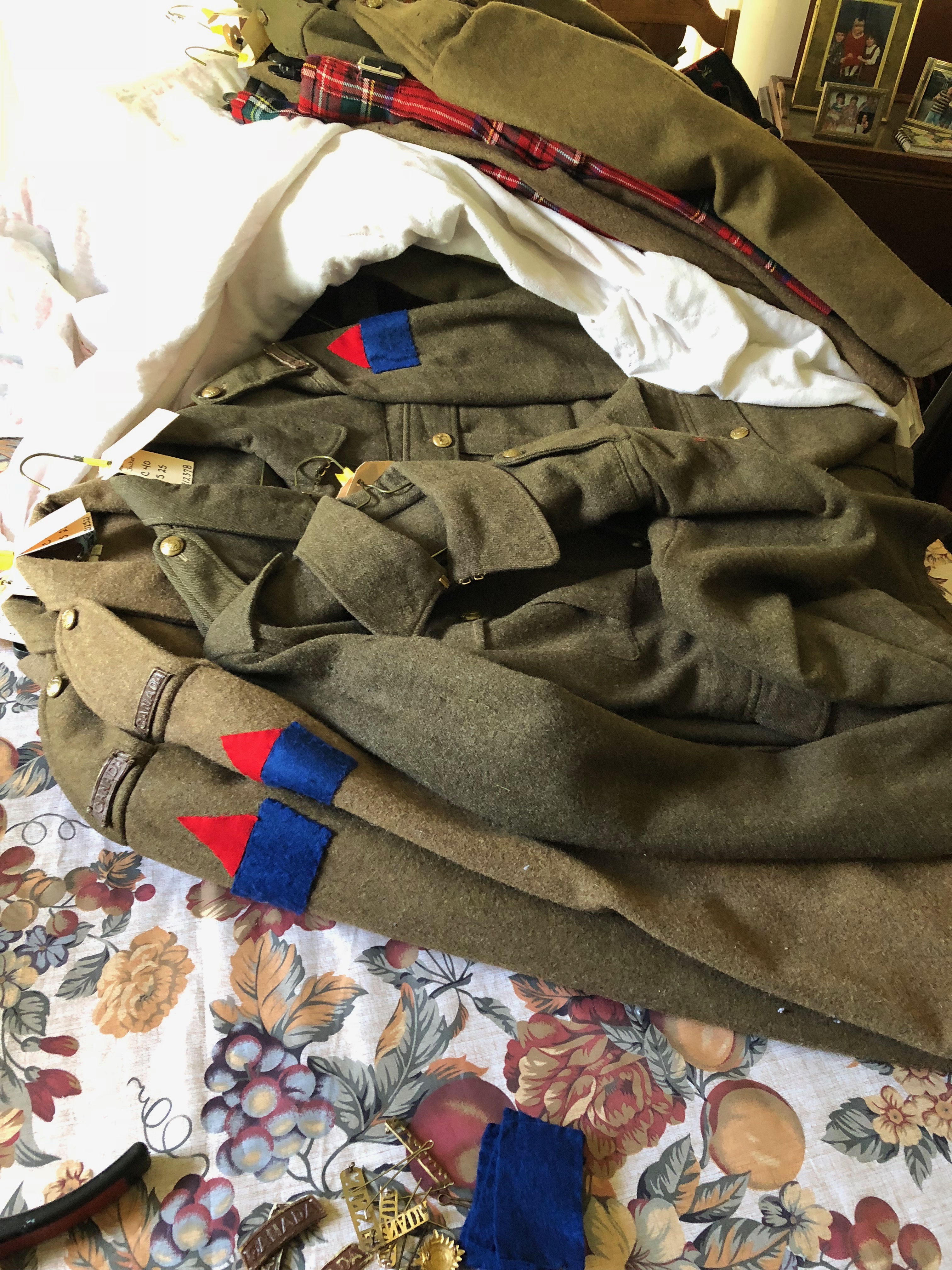
- Details
Kit Distribution Nearing Completion
The gathering and distribution of WW1 kit is nearing completion. Re-enactors in British Columbia, Regina, Hamilton and Ottawa and area have received their boxes of kit and the Montreal area volunteers are next. We are watging a bit of a challenge this week with the Canada Post rotating strikes.
We'd like to thank a couple of partners that helped us on the kit front, namely; the Royal Nova Scotia International Tattoo and the Halifax Citadel, without whose resources we would have been hard pressed to remain as accurate as we intended to be.
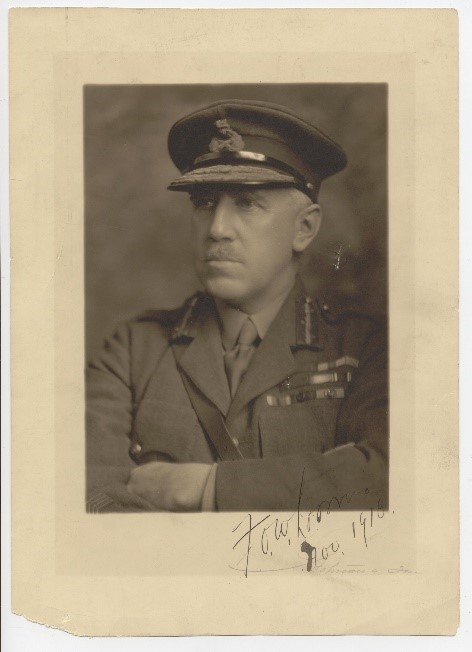
- Details
MGen Frederick O.W. Loomis
The last 20 days of the 100 days leading to the end of World War I
The following is a transcription of the General’s War Diary, held by the Black Watch (RHR) of Canada’s Museum and Archives. General Loomis had enrolled in the Royal Highlanders of Canada before the war and commanded its 13th Battalion before starting his promotions and ended the war as Commander of the 3rd Canadian Division. In 1919 he was knighted and lived in Montreal until he died in 1937. He is referred to as G.O.C. = General Officer in Command.
October 23, 1918 Somain and Wallers Rain
At 1000 hours, the G.O.C. left Somain in a car and motored to Waller’s where new Divisional Headquarters were opened at 1400 hrs. The G.O.C.’s office and room were previously occupied a short while before by the German Army Commander Von Graff.
The G.O.C. then went forward and visited first of all the 9th Canadian Infantry Brigade Headquarters in Raismes, then the 7th Canadian infantry brigade Headquarters on the road between Raismes and St. Amand. While he was at the 9th Cdn. Inf. Bde. HQs the Prince of Wales arrived with Capt. Lord Claud Hamilton. After discussing the situation with the Brigadiers of the respective brigades, the G.O.C. left in company with Brigadier General Clarke, visiting the Headquarters of the 49th Canadian Infantry Battalion, situated in the Foret de Raismes just south of Odomez.
On returning to Headquarters, he found that the Brigadier General Lord Brook had called to see him while he was out. A few minutes later, Brigadier General Lord Brook again called to see the G.O.C.. After they had talked, the Lord Brook returned to the 4th Canadian Division where he was staying. The situation throughout the day has been quiet. Patrols have kept in touch with the enemy; but the brigades have avoided committing themselves to an engagement.
The case of civilians in the more forward to part of the recently recaptured territory is extremely distressing. There are many cases of sickness among the old man, women and children. Everything is being done to evacuate these unfortunates to a region where greater safety and comfort can be procured for them.
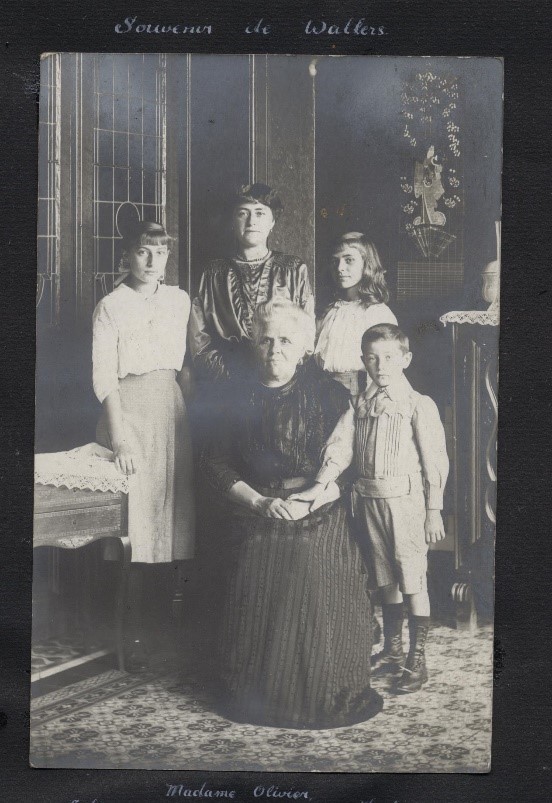
|
Figure 1 Madame Olivier and her children in Wallers, from Loomis scrapbook. |
October 24, 1918 Wallers Fine
During the morning, the Corps Commander called on the G.O.C. and stayed with him about two hours, discussing matters of policy connected with the operations.
In the afternoon, this G.O.C. went around various parts of the Divisional Area. The situation has been fairly quiet.
October 25, 1918 Wallers Fine
By Arrangement, Lord Brook visited the Division today. The G.O.C. took him around the whole of the forward area of the Division, visiting the 7th and 9th Brigades, and units holding the Line.
The enemy has commenced a policy of shelling in a desultory way the recently recaptured villages in the neighbourhood, thus making the lot of the repatriated civilians harder than ever.
October 26, 1918 Wallers Fine
During the morning, the G.O.C. saw various officers of the Divisional Staff in regard to the work of the Division.
In the afternoon, the G.O.C. visited the shops of the 3rd Canadian Division Mechanical Transport Company.
From there he called on the G.O.C 6th Canadian Infantry Brigade at present in Somain.
The question of dealing with the epidemic of influenza that exists among the civilians was brought up. This illness according to the civilians was rampant among the Huns; and the civilian population, debilitated by lack of food and hardship, which they have endured for the past three years, fell victim to the disease, entailing in some cases, severe suffering.
At the present moment, 14 cases have occurred within the Division. Steps are being taken to watch the progress of the disease vigilantly, and all is being done to arrest the further spread.
October 27, 1918 Wallers Rain
The disposition of Brigades in this Divisional Sector on this date was as follows:
7th Canadian Infantry Brigade: Left Section.
9th Canadian Infantry Brigade: Right Section.
8th Canadian Infantry Brigade: Divisional Reserve.
The 8th Cdn. Inf. Bde. relieved the 7th Cdn. Inf. Bde. on the night of October 27/28th.
The day passed quietly. Very little enemy activity reported.
The GOC spent the day working at Divisional Headquarters.
Captain W. D. Harridge, M.C., came to dinner.
Colonel C. P. Templeton, D.S.O. returned from leave; and Lieut-Col. Leash, who had been acting A.D.M.S. Division, during Col. Templeton’s absence, returned to his Field Ambulance.
October 29, 1918 Wallers Showers
During the morning, the G.O.C. worked at Divisional Headquarters.
In the afternoon, he visited the shops of the Divisional Mechanical Transport.
The day was quiet. Work on the roads was continued and they are now in good condition for the most part.
October 30, 1918 Wallers Fine
During the morning, the G.O.C. visited the 7th Cdn. Inf. Bde., then the 8th Cdn. Inf. Bde. Where he stayed to lunch.
He then proceeded to Raimes where he inspected he factory of the Franco-Belgium Company which had bee converted by the Germans into a munitions factory and where there were stored a very large number of dummy tanks. He then went to Vicoigne.
In the course of the morning, the Corps Commander called while the G.O.C. was out.
Enemy artillery showed a very appreciable in activity today, and during the early part of the night, there was some bombing activity.
Colonel Matthews also called in the afternoon before the G.O.C. returned.
October 31, 1918
During the morning, the G.O.C. worked at Divisional Headquarters. General Hayter, B.G., S.G. , called on the G.O.C., and discussed with him matters relative to the holding of the front line.
In the afternoon, the G.O.C. visited the workshops of the 3rd Canadian Division Mechanical Transport Coy.
On returning home he found that Major R. Heron, G.H.Q., had called and was staying to tea.
In the evening, the G.O.C. interviewed certain officers of the Division.
The enemy continues to show a certain amount of artillery activity, and has shelled Raimes and St. Amand with shrapnel.
G.H.Q. Report by wire was received today stating the Austria had signed armistice on very favorable terms.
November 1, 2018 Wallers Fine
In the early hours of the morning, the 4th Canadian Division attacked south of Valenciennes, their objective being to take that town from the south. The attack was made in conjunction with the 49th British Division. An unusually heavy barrage was arranged for this attack, there being eight (8) Brigades of 18-pounders on one brigade front, with other guns in proportion.
During the morning, the G.O.C. motored to Denain, where the Headquarters of the 4th Canadian Division were. There he saw Lieut.-Col. H.A. Panet, C.M.G., D.S.O., G.S.O. 1, 4th Canadian Division and Major-General Sir Daniel Watson, K.G.B., C.M.G., being out.
The G.O.C. then motored to Thiant, where Divisional Headquarters of the 49th British Division were located.
He then proceeded to the Headquarters of the 10th Cdn. Inf. Bde. at Maing where he met General Watson.
Evidence that the attack had been successful were present on the roads in the shape of a large number of prisoners, about 1200 being seen in the course of the morning’s drive. The French women and children were unable to resist lining the roads as these prisoners went by. Beyond indulging to the extent of laughing and pointing at the prisoners, they entirely refrained from ill-treating them in any way.
The G.O.C. returned home to lunch. After lunch, Captain Perslow, M.C., R.A.F., who had been one of the G.O.C.’s officers in the 2nd Cdn. Inf. Bde. called on the G.O.C..
During the afternoon, he proceeded to the HQs of the 8th C.I.B. and discussed the situation that had arisen with Brig. Gen. Draper as a result of the attack to our south.
November 2, 1918 Wallers Rain
The G.O.C. worked at the Divisional Headquarters in the morning, and saw General Hayter, B. G., G.S, Canadian Corps, who called.
After lunch, the G.O.C. visited first of all the headquarters of the 9th Cdn. Inf. Bde., then the 4th and 5th (?) Canadian Mounted Rifle Battalions after which he called on Brig-Gen. D,C. Draper, D.S.O. Codg. 8th Cdn. Inf. Bde. At his headquarters, where he stayed to tea.
November 3, 1918 Wallers Showers
The GOC spent of the morning working at Divisional Headquarters.
In the afternoon, he interviewed Brigadier - General Stewart, of the Divisional Artillery, and General Hayter, B.G, G.S. at Divisional Headquarters. Brig. Generals Ormond and Clark came to tea.
November 4, 1918 Raismes Fine
Divisional headquarters closed that Wallers at 10:00 hrs., opening at the same hour in Raismes.
At 0900 hrs., the GOC left Wallers in a car and visited, first of all, the 8th Canadian Infantry Brigade Headquarters at Beuvrages, where he discussed the situation with Brig.- Gen. Draper. While he was there the Corps Commander arrived. He then motored through Bruay into Valenciennes, and from thence on forward into Onnaig. Afterwards, he visited the Headquarters of the 1st Canadian Mounted Rifles Battalion, proceeding from thence forward to a crater just about 1600 yards west of Vicq. On returning back he again met General. Draper, and had a short consultation with him.
Valenciennes, although very much battered in places, is for the most part, in fairly good condition. A considerable number of civilians were seen in the town, the centre part of which is hardly destroyed at all. The enemy still continues his systematic pillaging of civilian residences.
It is noticeable that he has destroyed the railways very thoroughly in this area.
The inundations to the east of the Canal de l’Escaut although they have been subsided to a marked degree, are still a sufficiently extensive to hamper movement on this front.
Owing to good visibility, enemy aircraft as well as our own, was extremely active today.
November 5, 1918 Rasimes Rain
During the morning, the G.O.C. worked at Divisional Headquarters. General Hayter, B.G., G.S. called to discuss operations with the G.O.C.. Captain H.R.H. the Prince of Wales called on the G.O.C. on his way to the 7th Canadian Infantry Brigade.
In the afternoon, the G.O.C. visited the forward areas and inspected the terrain over which fighting was going on, as far as possible. The Canal de L’Escaut which he viewed in the vicinity of Talers (?) shows abundant signs of the Hun’s intention to make a stand at this point. The east bank of the canal is in process of being very strongly wired, and the locks have been very cleverly dammed; trenches have been dug, and everything goes to point towards the intention on the part of the Hun to construct an organized system of defences at this spot.
November 6, 1918 Valenciennes Rain
In the morning, Divisional Headquarters moved to No.9 Rue d’Outrelman, Vallenciennes.
In the morning, the G.O.C. accompanied by Lieut.-Col. W.W. Gibson, A.A. & G.M.Q, motored to Denain than to attend a conference at Canadian Corps Headquarters, where matters relating to demobilization of the army after the war were discussed. He then proceeded to Divisional Headquarters at Valenciennes.
In the afternoon, he motored to a Onnaing, where he visited the 8th and 7th Canadian Infantry Brigades discussing the operations that were taking place with the respective brigadiers.
In the evening, the G.O.C. dined with Major General Sir Daniel Watson, K.C.B., C.M.G., D.S.O, Commanding 4th Canadian Division, where he also met Sir Montague Allen, Honorary Colonel of the Regiment which the G.O.C. commanded at the beginning of the war, the Royal Highlanders of Canada.
The roads in this area are very bad, being blown up in many places, which results in considerable congestion of traffic.
November 7, 2018 Valenciennes Wet
The G.O.C. worked at Divisional Headquarters in the morning.
Lieu-General Sir Arthur W. Currie, visited the G.O.C. and stayed to lunch.
In the afternoon, the G.O.C. again worked at D. HQs. General Hayter, B.G., G.S., C.M.G., D.S.O., called. Lieut-Col A. Hamilton-Gault, D.S.O., P.P.C.L.I. and Lieut-Col. C.H. Hill, D.S.O., Royal Canadian Regiment visited Divisional Headquarters, where they are staying overnight a Guests of the G.O.C.. Colonel Gault dined with “A” Mess, and Colonel Hill with “C” Mess.
The Division has been able to make a very considerable advance today. A report has been received that a German plenipotentiary has crossed the line on the French front with the white flag to ascertain our terms of peace. News was received this afternoon of the capture of Sedan by the French. When one remembers the significance of this name, one can not help feeling what a great step has been taken towards avenging “1870”.
During the day, the Army Commander, made a state entry into Valenciennes, where he was received by the civic fathers in the Grand Place with becoming ceremony. Copy of terms of armistice with Turkey was received, which provides for a free passage for Allied Fleets thru the Bosporus to Black Sea, occupation of forts in the Dardanelles and Bosporus necessary to secure their passage, and the immediate repatriation of all Allied prisoners of war.
November 8, 2018 Valenciennes Rain
The G.O.C. worked at his Headquarters during the morning, and a conference at which the Corps Commander presided was held.
Immediately after lunch, the G.O.C. proceeded by motor car to the forward area. Near the Belgian Border, owing to the road having been mined, he was obliged to make a detour and go forward by way of Thulin and Hainin. The enemy at the time was in the eastern outskirts of Boussau, our line running through the town.
November 9, 1918 Valenciennes Fine
The G.O.C. worked at Headquarters in the morning. The Corps Commander called. In the afternoon, the G.O.C. went forward to Jemappes, Belgium, and viewed as far as possible, the terrain over which fighting was in progress.
November 10, 1918 Valenciennes & Jemappes Fine
Divisional Headquarters moved to Jemappes, Belgium, at 0900 hours. The G.O.C. made his headquarters at the Villa du Bosqued. The G.O.C. left Valenciennes at 0800 hours, and proceeded by motor car to the eastern outskirts of Jesmappes, after which he visited the Headquarters of the 7th, 8th and 9th Canadian Infantry Brigades, returning about 0330 hours to Headquarters.
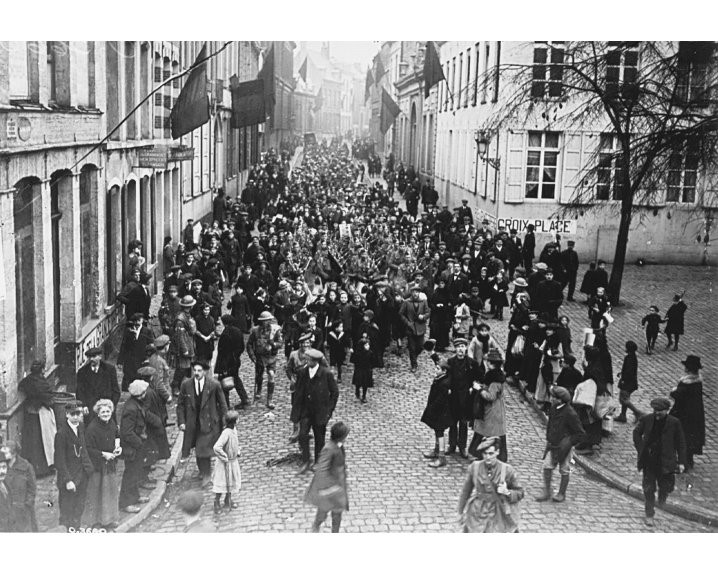
|
Figure 2 The 42nd Bn marches through the liberated town of Mons lead by the Pipe Band, 11 November 1918 |
November 11, 1918 Jemappes and Mons Unsettled
In the early morning, news was received that Germany had accepted all the Allies’ terms and that hostilities would cease at 1100 hours. Prior to the cessation of hostilities the 7th Canadian Infantry Brigade, after some fairly stiff fighting, captures and entered the whole of Mons. The attached telegram was received by the G.O.C. from the Corps Commander. The G.O.C. sent the following wire in reply: “Many thanks for your congratulations on the recapture of the historic battlefield and town of Mons.”
In the morning, the G.O.C. of the 7th Cdn. Inf. Bde. made a formal entry into Mons. At mid-day, Divisional Headquarters removed from Jemappes to Mons; and at 1530 hours, at the special request of the G.O.C., the Corps Commander made a formal entry into Mons.
The procession was made up of a troop of Lancers, every man of which, including the Officer in charge, had been at Mons in the fighting of 1914. Following the squadron came the Canadian Corps Commander and the G.O.C. preceded by their A.D.C.s. Then came General Hayter, B.G., G.S., and General Farmar, B.G., G.S., followed by various other officers of the staffs of the Corps Commander and G.O.C..
The procession proceeded from the southern limits of the town to the Grand Place, via the Boulevard Nimy. In the Grand Place, there were drawn up representatives of all the units within the Division, and also of all those associated with the Division in the capture of the City. On the Corps Commander’s entering the Grand Place, the general salute was given by General Stewart, B.G., C.R.A., who was in command of the parade. During the salute, the band of the Royal Canadian Regiment played the national anthems of the Allied Countries.
The Corps Commander then dismounted and was received by the Burgomaster of Mons and by the vice-president of the Belgian Parliament, and other of the city fathers. The Burgomaster tendered an address of thanks to the Corps Commander, expressing his appreciation of the deliverance of the City from the hands of the Boche, and of his gratitude to all the Allied armies. He also expressed the joy felt by all that after more than four years of war, most complete and glorious victory had at length been attained. The Corps Commander replied in suitable terms, and presented his pennant to the City of Mons. The Corps Commander then called for three cheers for the King of the Belgians. After this, the troops marched past the Corps Commander. The Corps Commander, Division Commander and their staffs were then conducted to the Hotel de Ville by the Burgomaster, where they signed their names in the Golden Book of Mons. Afterwards they were provided with light refreshments.
When the ceremony was over the G.O.C. and the Corps Commander visited Brigadier-General Clark, DSO, Commanding 7th Cdn. Inf. Bde., where they had tea. After tea, the Corps Commander left for Valenciennes.
In the evening, the G.O.C. gave a dinner to celebrate peace, at which there were present the members of “A” Mess, Brigadiers Clark, Draper and Ormond and Lieut-Col., A. Hamilton Gault.

- Details
Drum Restoration project
For several months now, historians and historic drum experts have been working hard to resurrect, refurbish and restore drums that would have been played in WW1.
Their hard work and dedication is coming to fruition as you can see in the pictures. A bass drum, from the period, and as would have been played by Cpl George Ritchie, is being restored as well.
Here is the rebuilt bass drum, finished on 29 September 2018.
